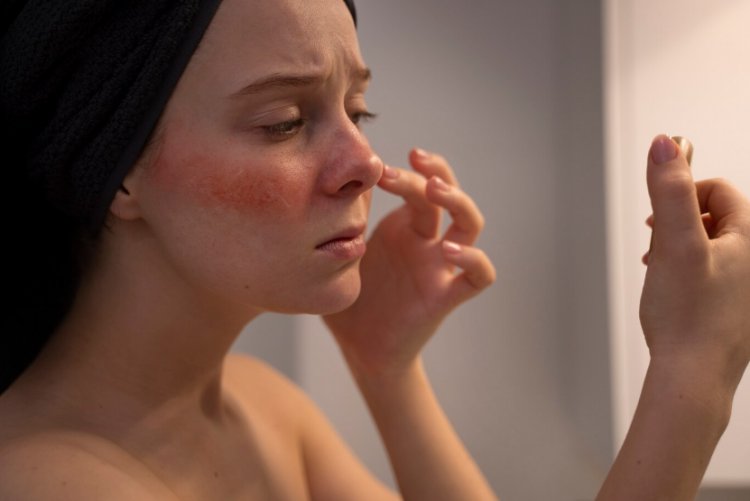Rosacea: Understanding the Chronic Skin Condition
Rosacea is a common chronic skin disorder that predominantly affects the face, characterized by persistent redness, visible blood vessels, bumps, and sometimes eye irritation. Despite its prevalence, rosacea remains widely misunderstood, often mistaken for acne or other skin conditions. This comprehensive guide aims to provide an in-depth understanding of rosacea, including its symptoms, subtypes, potential causes, triggers, diagnosis, and management strategies.

Symptoms
Facial Redness: One of the most prominent features of rosacea is persistent facial redness, typically affecting the central face, including the cheeks, nose, chin, and forehead. This redness may vary in intensity and can resemble a sunburn or blush.
Telangiectasia: Visible blood vessels, or telangiectasia, may become apparent on the skin's surface, particularly on the cheeks and nose. These small, dilated blood vessels contribute to the overall redness and can be a key diagnostic feature of rosacea.
Papules and Pustules: Inflammatory papules and pustules resembling acne lesions may develop in individuals with rosacea. These bumps are often dome-shaped and may contain pus. Unlike acne, these lesions typically do not present with blackheads or whiteheads.
Thickened Skin: In some cases, especially in men, rosacea can lead to thickening of the skin on the nose, a condition known as rhinophyma. This enlargement of the nose may result in a bulbous appearance and is often associated with advanced stages of rosacea.
Ocular Symptoms: Rosacea can affect the eyes, leading to a range of symptoms collectively known as ocular rosacea. These symptoms may include dryness, irritation, burning, stinging, and sensitivity to light. Without proper management, ocular rosacea can lead to more serious complications, such as corneal damage.
Subtypes
Rosacea manifests in various clinical subtypes, each with its distinct features:
Erythematotelangiectatic Rosacea: Characterized by facial redness and visible blood vessels, this subtype is the most common form of rosacea.
Papulopustular Rosacea: In addition to facial redness, individuals with this subtype experience papules, pustules, and swelling, often resembling acne vulgaris.
Phymatous Rosacea: This subtype involves thickening of the skin, particularly on the nose (rhinophyma), but may also affect other facial areas.
Ocular Rosacea: Primarily affecting the eyes, ocular rosacea presents with symptoms such as dryness, irritation, and inflammation of the eyelids (blepharitis) and conjunctiva (conjunctivitis).
Causes and Triggers
The exact cause of rosacea remains elusive, but several factors are thought to contribute to its development:
Genetic Predisposition: Family history may increase the likelihood of developing rosacea, suggesting a genetic component to the condition.
Dysregulation of the Immune System: Abnormalities in the immune response and inflammatory pathways may play a role in rosacea's pathogenesis.
Dermatologic Factors: Factors such as increased presence of Demodex mites, alterations in facial blood vessels, and dysbiosis of the skin microbiome have been implicated in rosacea.
Environmental Triggers: Various environmental factors can exacerbate rosacea symptoms, including sun exposure, extreme temperatures, wind, spicy foods, alcohol consumption, stress, and certain skincare products.
Diagnosis
Diagnosing rosacea typically involves a thorough medical history, physical examination, and evaluation of symptoms. No specific diagnostic test exists for rosacea; instead, healthcare providers rely on clinical features to make a diagnosis. In some cases, additional tests may be conducted to rule out other conditions or assess ocular involvement.
Management and Treatment
While rosacea cannot be cured, several treatment options can help manage symptoms and improve quality of life:
Topical Therapies: Prescription creams or gels containing ingredients such as metronidazole, azelaic acid, or ivermectin can reduce inflammation and redness associated with rosacea.
Oral Medications: Oral antibiotics, such as doxycycline or isotretinoin, may be prescribed for more severe cases to control inflammation and prevent flare-ups.
Laser and Light Therapies: Procedures such as laser therapy, intense pulsed light (IPL) therapy, and photodynamic therapy (PDT) can target visible blood vessels, reduce redness, and improve overall skin texture.
Ocular Management: Lubricating eye drops, oral antibiotics, and other medications prescribed by an ophthalmologist can help manage ocular rosacea symptoms.
Lifestyle Modifications: Identifying and avoiding triggers, practicing sun protection, gentle skincare routines, and managing stress can all contribute to better management of rosacea symptoms.
Conclusion
Rosacea is a complex and multifaceted skin disorder characterized by facial redness, visible blood vessels, bumps, and ocular symptoms. While its exact cause remains uncertain, genetic predisposition, immune dysregulation, dermatologic factors, and environmental triggers are believed to contribute to its development. Understanding the symptoms, subtypes, triggers, and available treatment options is crucial for effectively managing rosacea and improving the quality of life for individuals affected by this condition.
Centers or Clinics in the United Kingdom
-
The Harley Street Dermatology Clinic - Located in London, this clinic offers specialized dermatological services, including diagnosis and treatment of rosacea.
-
The British Skin Foundation - As a national charity dedicated to skin research, this organization provides information and support for individuals with skin conditions like rosacea.
-
The London Dermatology Centre - Situated in central London, this center provides comprehensive dermatological services, including consultations, diagnostics, and treatments for rosacea and other skin conditions.
-
The Cadogan Clinic - Based in Chelsea, London, this clinic offers a range of medical and cosmetic dermatology services, including consultations and treatments for rosacea.
-
The Skin Hospital - Located in Birmingham, this hospital specializes in dermatological care and offers consultations and treatments for various skin conditions, including rosacea.
Centers or Clinics in Turkey
-
Estetik International - With multiple locations across Turkey, Estetik International offers dermatological services, including diagnosis and treatment of rosacea, along with cosmetic procedures.
-
Acıbadem Healthcare Group - As one of the largest healthcare providers in Turkey, Acıbadem offers dermatological services at its hospitals and clinics across the country, including consultations and treatments for rosacea.
-
Dermakol Klinik - Located in Istanbul, Dermakol Klinik specializes in dermatology and aesthetic treatments, providing services for rosacea diagnosis and management.
-
Memorial Healthcare Group - With hospitals and medical centers in various cities in Turkey, Memorial Healthcare Group offers dermatological services, including consultations and treatments for rosacea.
-
Istanbul Dermatoloji Grubu - Situated in Istanbul, this dermatology group provides specialized care for various skin conditions, including rosacea, through consultations, diagnostics, and treatment plans.

Discover Coupoly's exclusive Medical Concierge Service, connecting you with renowned doctors and clinics, alongside our complimentary Travel Concierge Service, linking you with top UK travel agencies.
Contact us now to learn more.
Get in Touch
What's Your Reaction?





















